Effect of Sulfurization Time on the Physical Properties of Tin (II) Monosulfide Thin Films
Abstract
:1. Introduction
2. Experimental Details
3. Results and Discussion
3.1. XPS Analysis
3.2. XRD Analysis
3.3. Raman Studies
3.4. AFM Studies
3.5. Optical Studies
4. Conclusions
Author Contributions
Funding
Institutional Review Board Statement
Informed Consent Statement
Data Availability Statement
Acknowledgments
Conflicts of Interest
References
- Kushiya, K. CIS-based thin-film PV technology in solar frontier K.K. Sol. Energy Mater. Sol. Cells 2014, 122, 309–313. [Google Scholar] [CrossRef]
- Avrutin, V.; Izyumskaya, N.; Morko, H. Semiconductor solar cells: Recent progress in terrestrial applications. Superlattices Microstruct. 2011, 49, 337–364. [Google Scholar] [CrossRef]
- Vasudeva Reddy, M.; Sreedevi, G.; Chinho, P.; Miles, R.W.; Ramakrishna Reddy, K.T. Development of sulphurized SnS thin film solar cells. Curr. Appl. Phys. 2015, 15, 588–598. [Google Scholar] [CrossRef]
- Gedi, S.; Reddy, V.R.M.; Park, C.; Chan-Wook, J.; Ramakrishna Reddy, K.T. Comprehensive optical studies on SnS layers synthesized by chemical bath deposition. Opt. Mater. Amst. 2015, 42, 468–475. [Google Scholar] [CrossRef]
- Gedi, S.; Minnam Reddy, V.R.; Kotte, T.R.R.; Park, Y.; Kim, W.K. Effect of C4H6O6 concentration on the properties of SnS thin films for solar cell applications. Appl. Surf. Sci. 2019, 465, 802–815. [Google Scholar] [CrossRef]
- Sreedevi, G.; Vasudeva Reddy, M.; Babu, P.; Chan-Wook, J.; Chinho, P.; Ramakrishna Reddy, K.T. A facile inexpensive route for SnS thin film solar cells with SnS2 buffer. Appl. Surf. Sci. 2016, 372, 116–124. [Google Scholar] [CrossRef]
- Vasudeva Reddy, M.; Sreedevi, G.; Babu, P.; Ramakrishna Reddy, K.T.; Guillaume, Z.; Chinho, P. Influence of different substrates on the properties of sulfurized SnS films. Sci. Adv. Mater. 2016, 8, 247–251. [Google Scholar] [CrossRef]
- Nwofe, P.A.; Reddy, K.T.R.; Miles, R.W. Influence of Deposition Time on the Properties of Highly-Oriented SnS Thin Films Prepared Using the Thermal Evaporation Method. Adv. Mater. Res. 2012, 602–604, 1409–1412. [Google Scholar] [CrossRef]
- Nwofe, P.A.; Reddy, K.T.R.; Miles, R.W. Type conversion of p-SnS to n-SnS using a SnCl4CH3OH heat treatment. In Proceedings of the 2013 IEEE 39th Photovoltaic Specialists Conference, Tampa, FL, USA, 16–21 June 2013; pp. 2518–2523. [Google Scholar] [CrossRef]
- Mariappan, R.; Ragavendar, M.; Ponnuswamy, V. Structural and optical characterization of SnS thin films by electro-deposition technique. Opt. Appl. 2011, 41, 989–997. [Google Scholar]
- Ricica, T.; Strizik, L.; Dostal, L.; Bouska, M.; Vlcek, M.; Benes, L.; Wagner, T.; Jambor, R. SnS and SnS2 thin films deposited using a spin-coating technique from intramolecularly coordinated organotin sulfides. Appl. Organomet. Chem. 2015, 29, 176–180. [Google Scholar] [CrossRef]
- Sajeesh, T.H.; Poornima, N.; Sudha Kartha, C.; Vijayakumar, K.P. Unveiling the defect levels in SnS thin films for photovoltaic applications using photoluminescence technique. Phys. Status Solidi Appl. Mater. Sci. 2010, 207, 1934–1939. [Google Scholar] [CrossRef]
- Xie, H.; Sánchez, Y.; López-Marino, S.; Espíndola-Rodríguez, M.; Neuschitzer, M.; Sylla, D.; Fairbrother, A.; Izquierdo-Roca, V.; Pérez-Rodríguez, A.; Saucedo, E. Impact of Sn (S, Se) Secondary Phases in Cu2ZnSn(S, Se)4 Solar Cells: A Chemical Route for Their Selective Removal and Absorber Surface Passivation. ACS Appl. Mater. Interfaces 2014, 6, 12744–12751. [Google Scholar] [CrossRef]
- Sinsermsuksakul, P.; Sun, L.; Lee, S.W.; Park, H.H.; Kim, S.B.; Yang, C.; Gordon, R.G. Overcoming Efficiency Limitations of SnS-Based Solar Cells. Adv. Energy Mater. 2014, 4, 1400496. [Google Scholar] [CrossRef]
- Schneikart, A.; Schimper, H.J.; Klein, A.; Jaegermann, W. Efficiency limitations of thermally evaporated thin-film SnS solar cells. J. Phys. D. Appl. Phys. 2013, 46. [Google Scholar] [CrossRef]
- Banai, R.E.; Horn, M.W.; Brownson, J.R.S. A review of tin (II) monosulfide and its potential as a photovoltaic absorber. Sol. Energy Mater. Sol. Cells 2016, 150, 112–129. [Google Scholar] [CrossRef]
- Minnam Reddy, V.R.; Lindwall, G.; Pejjai, B.; Gedi, S.; Kotte, T.R.R.; Sugiyama, M.; Liu, Z.K.; Chinho, P. α-SnSe thin film solar cells produced by selenization of magnetron sputtered tin precursors. Sol. Energy Mater. Sol. Cells 2018, 176, 251–258. [Google Scholar] [CrossRef]
- Ahmet, I.Y.; Hill, M.S.; Johnson, A.L.; Peter, L.M. Polymorph-Selective Deposition of High Purity SnS Thin Films from a Single Source Precursor. Chem. Mater. 2015, 27, 7680–7688. [Google Scholar] [CrossRef] [Green Version]
- Joshi, M.P.; Khot, K.V.; Patil, S.S.; Mali, S.S.; Hong, C.K.; Bhosale, P.N. Investigating the light harvesting capacity of sulfur ion concentration dependent SnS 2 thin films synthesized by self-assembled arrested precipitation technique. Mater. Res. Express 2019, 6, 086467. [Google Scholar] [CrossRef]
- Calderón Triana, C.L.; Banguero, E.; Bartolo-Pérez, P.; Gordillo, G. Preparation and Characterization of SnS:Bi Thin Films. Braz. J. Phys. 2011, 41, 15–20. [Google Scholar] [CrossRef]
- Jing, L.; Xu, Y.; Zhang, M.; Xie, M.; Xu, H.; He, M.; Liu, J.; Huang, S.; Li, H. Novel Ag2S quantum dot modified 3D flower-like SnS2 composites for photocatalytic and photoelectrochemical applications. Inorg. Chem. Front. 2018, 5, 63–72. [Google Scholar] [CrossRef]
- Jiang, F.; Shen, H.; Gao, C.; Liu, B.; Lin, L.; Shen, Z. Preparation and properties of SnS film grown by two-stage process. Appl. Surf. Sci. 2011, 257, 4901–4905. [Google Scholar] [CrossRef]
- Sinsermsuksakul, P.; Heo, J.; Noh, W.; Hock, A.S.; Gordon, R.G. Atomic layer deposition of tin monosulfide thin films. Adv. Energy Mater. 2011, 1, 1116–1125. [Google Scholar] [CrossRef] [Green Version]
- Tanusevski, A. Optical and photoelectric properties of SnS thin films prepared by chemical bath deposition. Semicond. Sci. Technol. 2003, 18, 501–505. [Google Scholar] [CrossRef]
- Cheng, S.; He, Y.; Chen, G.; Cho, E.C.; Conibeer, G. Influence of EDTA concentration on the structure and properties of SnS films prepared by electrodeposition. Surf. Coat. Technol. 2008, 202, 6070–6074. [Google Scholar] [CrossRef]
- Chaki, S.H.; Deshpande, M.P.; Trivedi, D.P.; Tailor, J.P.; Chaudhary, M.D.; Mahato, K. Wet chemical synthesis and characterization of SnS2 nanoparticles. Appl. Nanosci. 2013, 3, 189–195. [Google Scholar] [CrossRef] [Green Version]
- Lu, F.Y.; Yang, J.H.; Li, R.X.; Huo, N.J.; Li, Y.T.; Wei, Z.M.; Li, J.B. Gas-dependent photoresponse of SnS nanoparticles-based photodetectors. J. Mater. Chem. C 2015, 3, 1397–1402. [Google Scholar] [CrossRef]
- Banu, S.; Ahn, S.J.; Eo, Y.J.; Gwak, J.; Cho, A. Tin monosulfide (SnS) thin films grown by liquid-phase deposition. Sol. Energy 2017, 145, 33–41. [Google Scholar] [CrossRef]


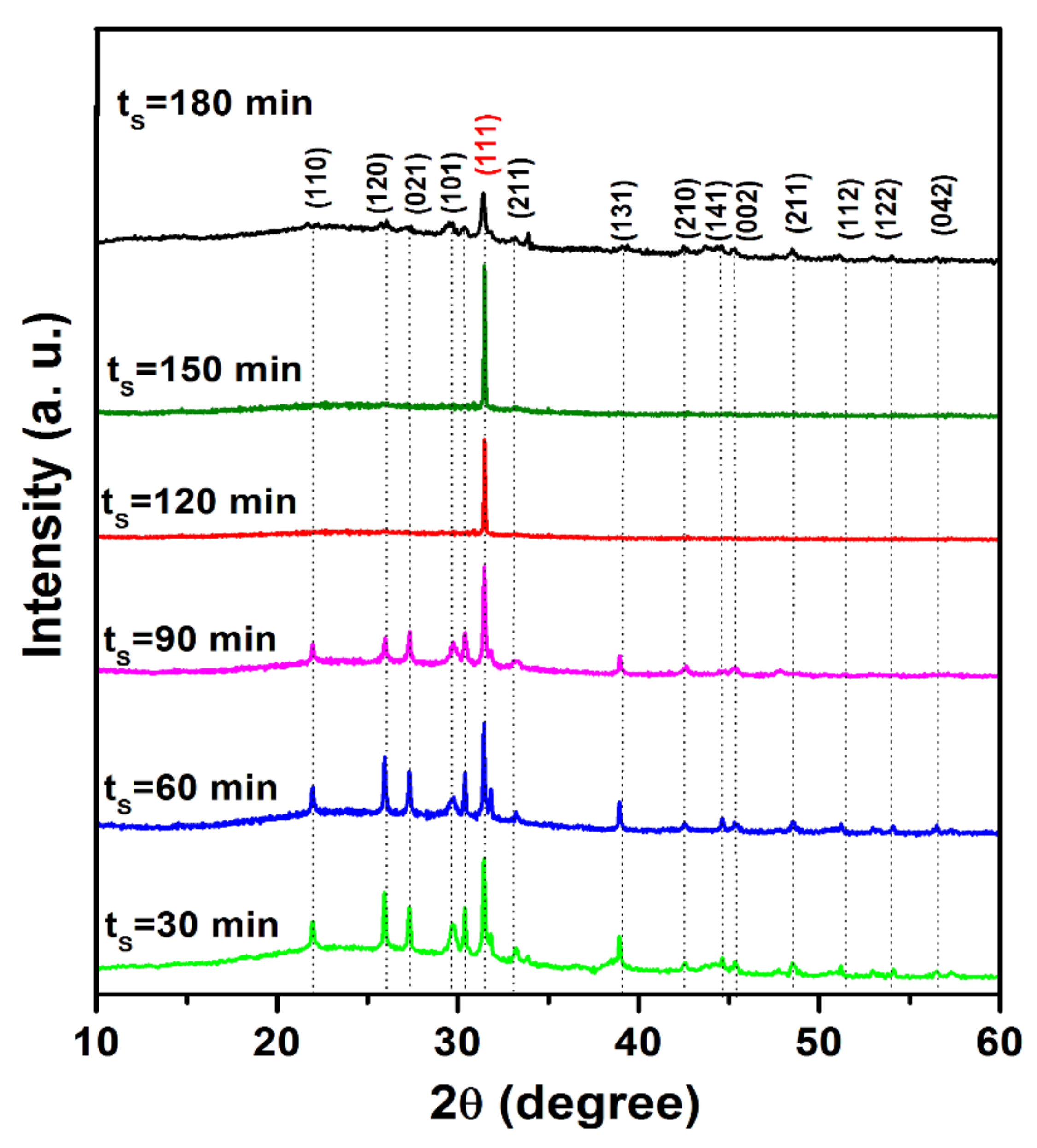

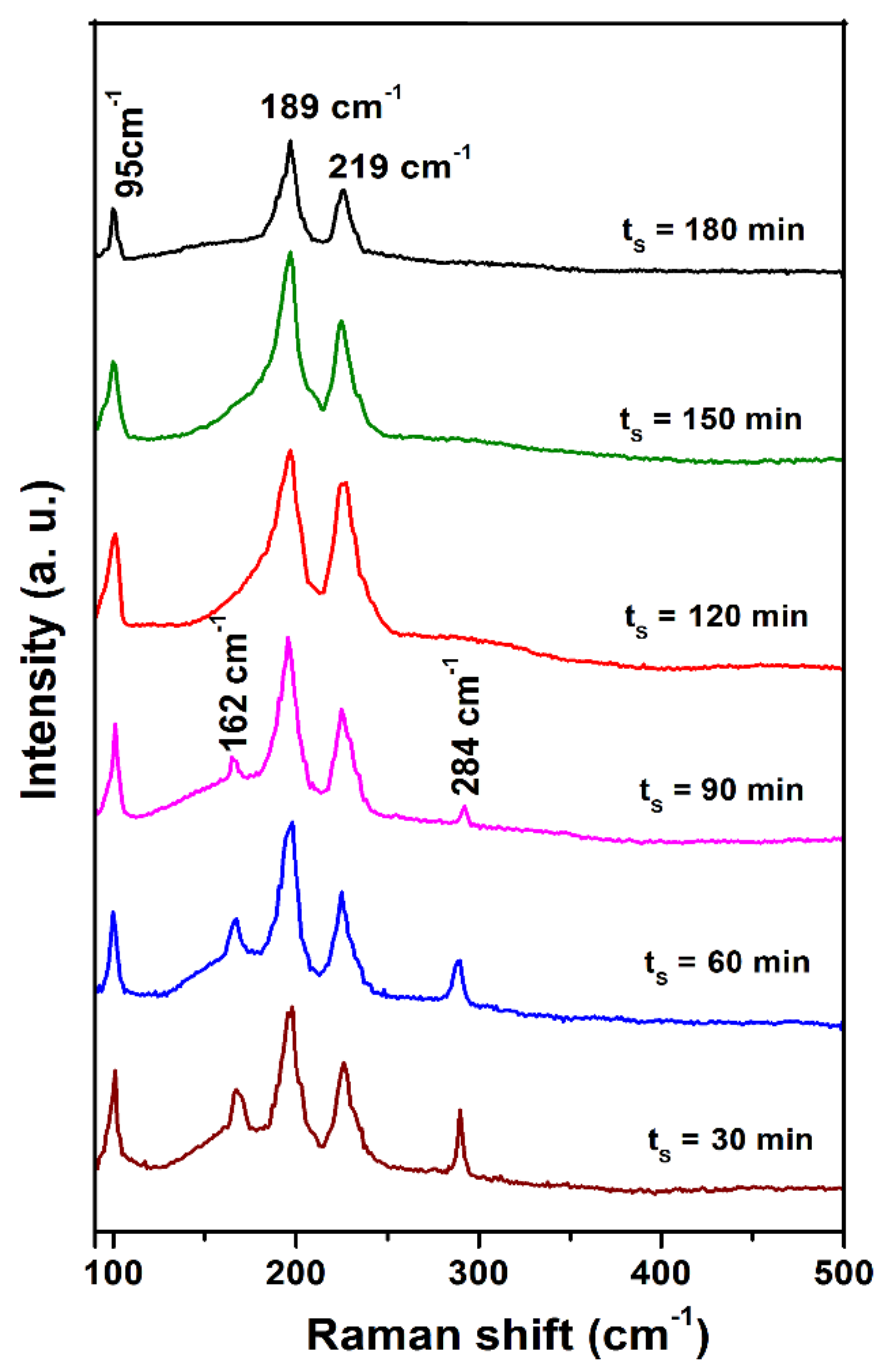
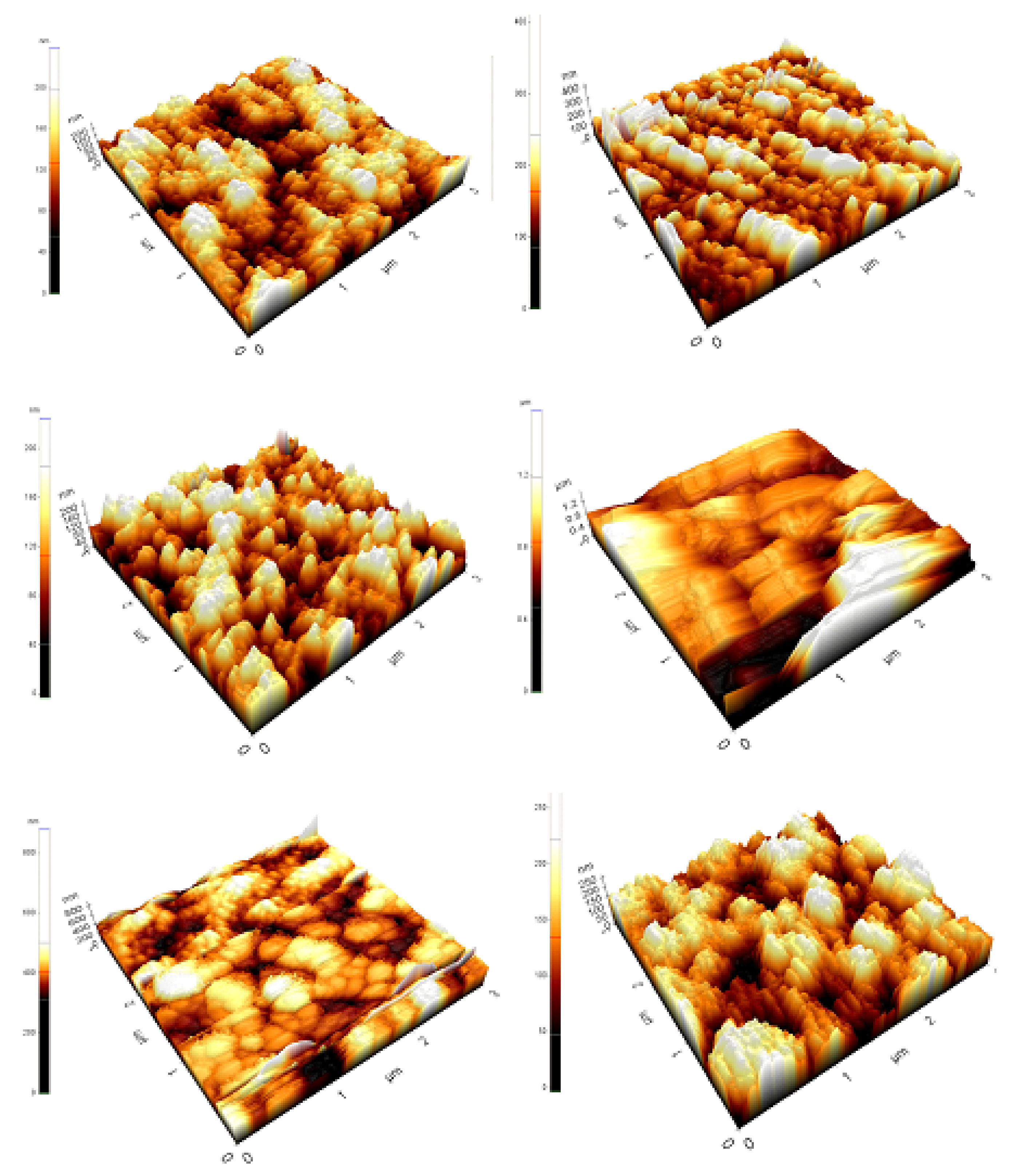
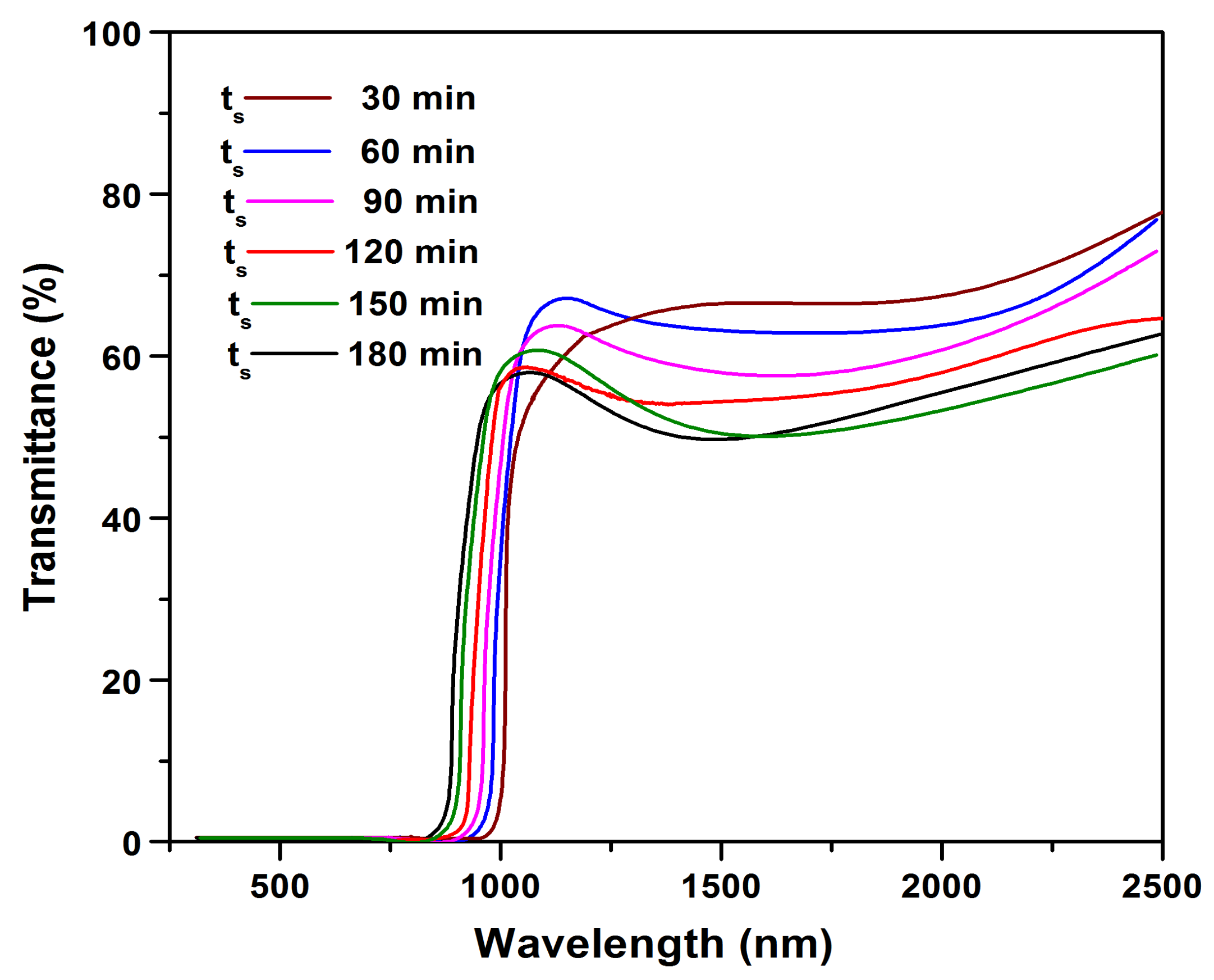
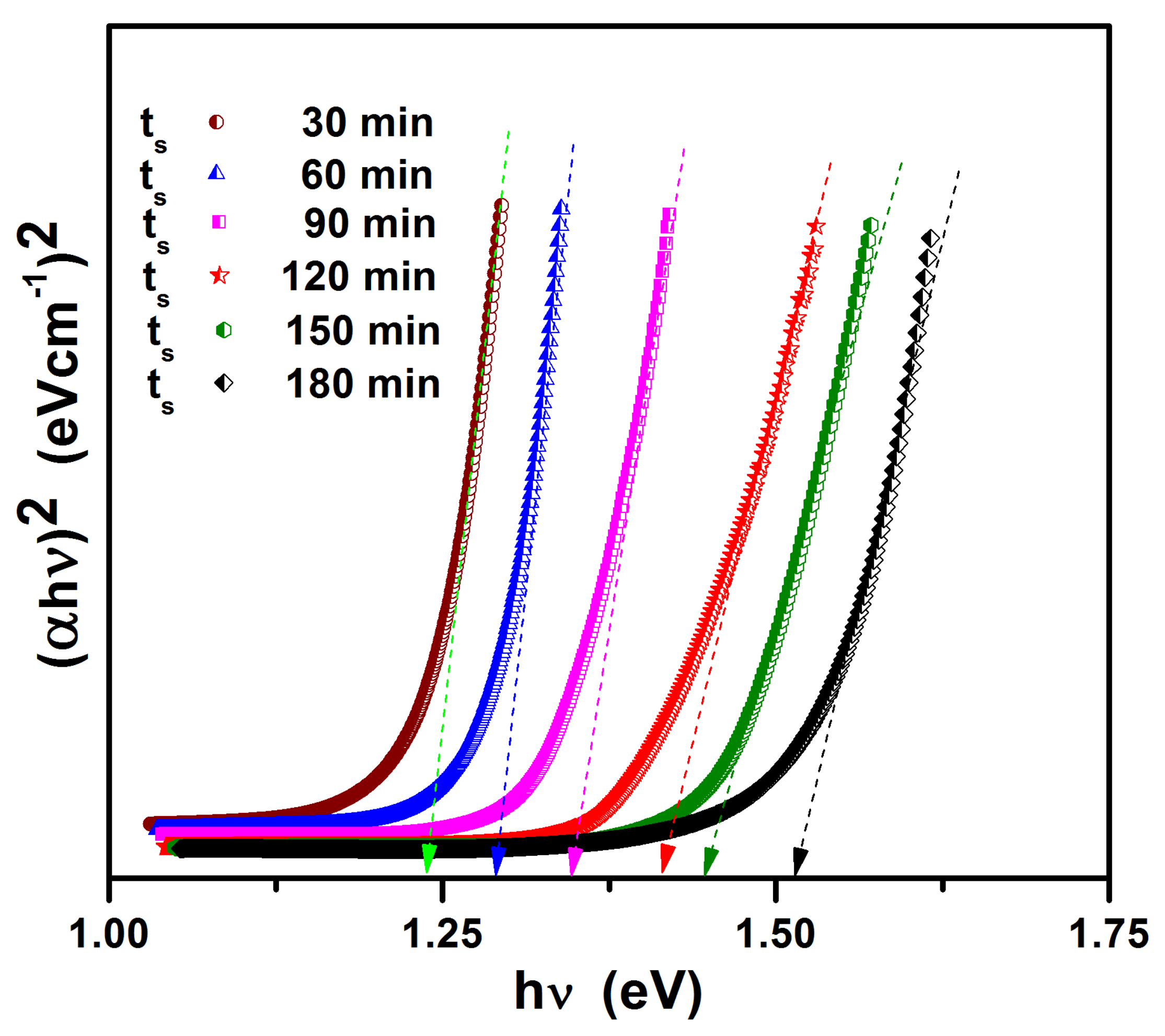
Publisher’s Note: MDPI stays neutral with regard to jurisdictional claims in published maps and institutional affiliations. |
© 2021 by the authors. Licensee MDPI, Basel, Switzerland. This article is an open access article distributed under the terms and conditions of the Creative Commons Attribution (CC BY) license (https://creativecommons.org/licenses/by/4.0/).
Share and Cite
Minnam Reddy, V.R.; Gedi, S.; Amate, R.U.; Ramakrishna Reddy, K.T.; Kim, W.K.; Park, C. Effect of Sulfurization Time on the Physical Properties of Tin (II) Monosulfide Thin Films. Crystals 2021, 11, 802. https://doi.org/10.3390/cryst11070802
Minnam Reddy VR, Gedi S, Amate RU, Ramakrishna Reddy KT, Kim WK, Park C. Effect of Sulfurization Time on the Physical Properties of Tin (II) Monosulfide Thin Films. Crystals. 2021; 11(7):802. https://doi.org/10.3390/cryst11070802
Chicago/Turabian StyleMinnam Reddy, Vasudeva Reddy, Sreedevi Gedi, Rutuja U. Amate, K. T. Ramakrishna Reddy, Woo Kyoung Kim, and Chinho Park. 2021. "Effect of Sulfurization Time on the Physical Properties of Tin (II) Monosulfide Thin Films" Crystals 11, no. 7: 802. https://doi.org/10.3390/cryst11070802






